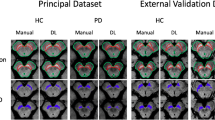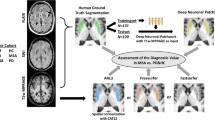Abstract
The Subthalamic Nucleus and Substantia Nigra have an important role in the treatment of Parkinson’s Disease (PD); however, they are difficult to identify on magnetic resonance imaging (MRI) and are of paramount importance in PD, which requires their precise localization. We present a pipeline methodology that allows autonomous segmentation of both structures, based on MRI T2-weighted images and Deep Learning techniques. Three segmentation architectures were compared: CLCI-Net, 3D U-Net and Conv-SeTr. All models were trained in two instances: the first with 60 T2-weighted standard protocol images from 1.5T MRI. Transfer learning was applied for the second instance in which the models were trained with 20 T2-weighted adjusted protocol images from 3T MRI. In all cases, the ground truth was obtained through manual segmentation by experts. All models produced an image mask with the segmented labelled structures co-registered to native space. The proposed transformer-based model segmented the volumes of interest with a DICE coefficient of 0.81 and an AVD of 0.06, which outperformed the other architectures. The Conv-SeTr presented promising results for segmenting Subthalamic Nucleus and Substantia Nigra, key structures in Parkinson’s disease research and treatment.
Access this chapter
Tax calculation will be finalised at checkout
Purchases are for personal use only
Similar content being viewed by others
References
Abteen Mostofi, F.M., et al.: Pain in Parkinson’s disease and the role of the subthalamic nucleus. Brain 144, 1342–1350 (2021). https://doi.org/10.1093/brain/awab001
Alexander, G.E., DeLong, M.R., Strick, P.L.: Parallel organization of functionally segregated circuits linking basal ganglia and cortex. Annu. Rev. Neurosci. 9, 357–381 (1986). https://doi.org/10.1146/annurev.ne.09.030186.002041
Andres, M., Lozano, N.L., et al.: Deep brain stimulation: current challenges and future directions (2019). https://doi.org/10.1038/s41582-018-0128-2
Anindya A, N.I., et al.: UNet-vgg16 with transfer learning for MRI-based brain tumor segmentation. Telkomnika (Telecommunication Computing Electronics and Control) 18, 1310–1318 (2020). https://doi.org/10.12928/TELKOMNIKA.v18i3.14753
Avants, B.B., Tustison, N., Song, G., et al.: Advanced normalization tools (ANTs). Insight J. 2(365), 1–35 (2009)
Basinger, H., Joseph, J.: Neuroanatomy, Subthalamic Nucleus (2022)
Braak, H., Del Tredici-Braak, K., Gasser, T.: Special issue Parkinson’s disease. Cell Tissue Res. 373(1), 1–7 (2018). https://doi.org/10.1007/s00441-018-2863-5
Ewert, S., Horn, A., Finkel, F., Li, N., Kühn, A.A., Herrington, T.M.: Optimization and comparative evaluation of nonlinear deformation algorithms for atlas-based segmentation of DBS target nuclei. Neuroimage 184, 586–598 (2019)
Goutte, C., Gaussier, E.: A probabilistic interpretation of precision, recall and F-score, with implication for evaluation. In: Losada, D.E., Fernández-Luna, J.M. (eds.) ECIR 2005. LNCS, vol. 3408, pp. 345–359. Springer, Heidelberg (2005). https://doi.org/10.1007/978-3-540-31865-1_25
Grimes, D., et al.: Canadian guideline for Parkinson disease. CMAJ 191 (2019). https://doi.org/10.1503/cmaj.181504
Yang, H., et al.: CLCI-Net: cross-level fusion and context inference networks for lesion segmentation of chronic stroke. In: Shen, D., et al. (eds.) MICCAI 2019. LNCS, vol. 11766, pp. 266–274. Springer, Cham (2019). https://doi.org/10.1007/978-3-030-32248-9_30
Hutchinson, M., Raff, U.: Structural changes of the substantia nigra in Parkinson’s disease as revealed by MR imaging. Am. J. Neuroradio. 21, 697–701 (2000)
Hwang, H., Rehman, H.Z.U., Lee, S.: 3D U-Net for skull stripping in brain MRI 9 (2019). https://doi.org/10.3390/app9030569
Iglovikov, V., Shvets, A.: TernausNet: U-Net with VGG11 encoder pre-trained on imagenet for image segmentation (2018)
Jethi, A.K., Murugesan, B., et al.: Dual-encoder-Unet for fast MRI reconstruction. Institute of Electrical and Electronics Engineers Inc. (2020). https://doi.org/10.1109/ISBIWorkshops50223.2020.9153453
Prakash, K.G., Bannur, B.M., et al.: Neuroanatomical changes in Parkinson’s disease in relation to cognition: an update. J. Adv. Pharm. Technol. Res. 7 (2016). https://doi.org/10.4103/2231-4040.191416
Li, H., et al.: Fully convolutional network ensembles for white matter hyperintensities segmentation in MR images. Neuroimage 183, 650–665 (2018)
Mena, R., Macas, A., Pelaez, E., Loayza, F., Franco-Maldonado, H.: A pipeline for segmenting and classifying brain lesions caused by stroke: A machine learning approach. In: Rocha, A., Adeli, H., Dzemyda, G., Moreira, F. (eds.) World Conference on Information Systems and Technologies, vol. 470, pp. 415–424. Springer, Cham (2022). https://doi.org/10.1007/978-3-031-04829-6_37
Obeso, J., Rodriguez, M., Gorospe, A., Guridi, J., Alvarez, L., Macias, R.: Surgical treatment of Parkinson’s disease. Bailliere’s Clin. Neurol. 6(1), 125–145 (1997)
Pati, S., et al.: Federated learning enables big data for rare cancer boundary detection. arXiv preprint arXiv:2204.10836 (2022)
Sixiao Zheng, J.L., et al.: Rethinking semantic segmentation from a sequence-to-sequence perspective with transformers (2021). https://doi.org/10.48550/arXiv.2012.15840
Uma, V., Mahajan, V.K.R., et al.: Bilateral deep brain stimulation is the procedure to beat for advanced Parkinson disease: a meta-analytic, cost-effective threshold analysis for focused ultrasound. Neurosurgery 88, 487–496 (2021). https://doi.org/10.1093/neuros/nyaa485
Viteri, J., Pelaéz, E., Loaiza, F., Layedra, F.: U-Net CNN model for segmentation of white matter hyperintensities (2020)
Zahra Izadifar, Z.I., et al: An introduction to high intensity focused ultrasound: systematic review on principles, devices, and clinical applications. J. Clin. Med. 9 (2020). https://doi.org/10.3390/jcm9020460
Zhu, L., Han, C., et al.: U-Net deep learning network for automatic segmentation and localization of prostate cancer on MRI apparent diffusion coefficient map. Chin. J. Radiol. 54, 974–979 (2020). https://doi.org/10.3760/cma.j.cn112149-20191004-00745
Author information
Authors and Affiliations
Corresponding author
Editor information
Editors and Affiliations
Rights and permissions
Copyright information
© 2024 The Author(s), under exclusive license to Springer Nature Switzerland AG
About this paper
Cite this paper
Nebel, J., Pinargote, F.E.M., Peláez, C.E., Paredes, F.R.L., Rodriguez-Rojas, R. (2024). Subthalamic Nucleus and Substantia Nigra Automatic Segmentation Using Convolutional Segmentation Transformers (Conv-SeTr). In: Rocha, A., Adeli, H., Dzemyda, G., Moreira, F., Colla, V. (eds) Information Systems and Technologies. WorldCIST 2023. Lecture Notes in Networks and Systems, vol 799. Springer, Cham. https://doi.org/10.1007/978-3-031-45642-8_36
Download citation
DOI: https://doi.org/10.1007/978-3-031-45642-8_36
Published:
Publisher Name: Springer, Cham
Print ISBN: 978-3-031-45641-1
Online ISBN: 978-3-031-45642-8
eBook Packages: Intelligent Technologies and RoboticsIntelligent Technologies and Robotics (R0)




